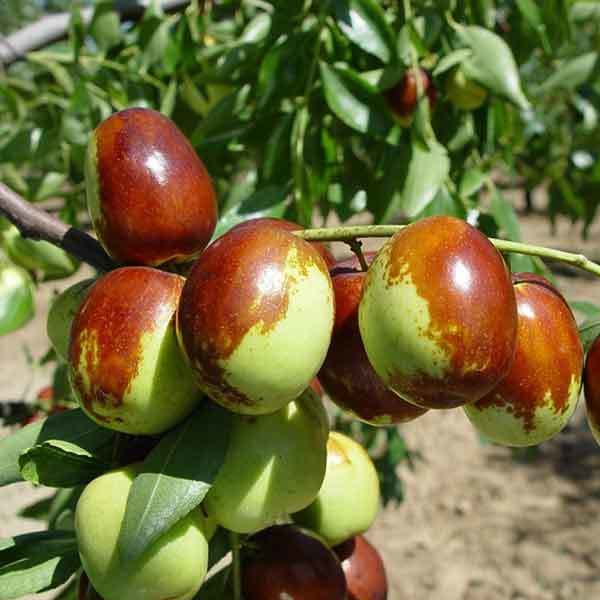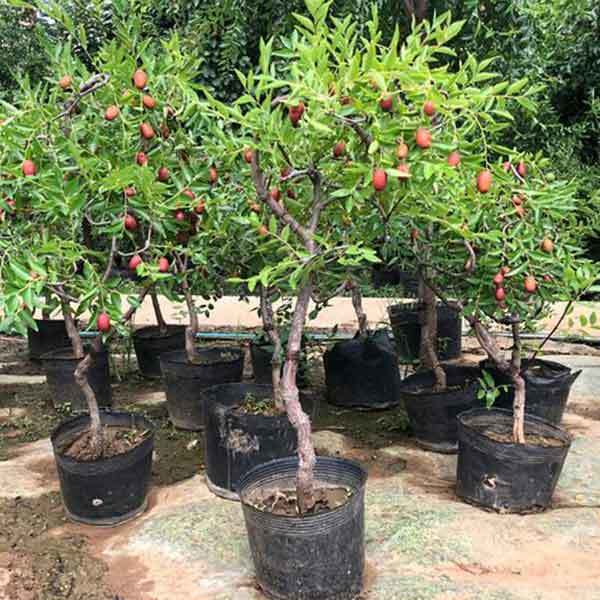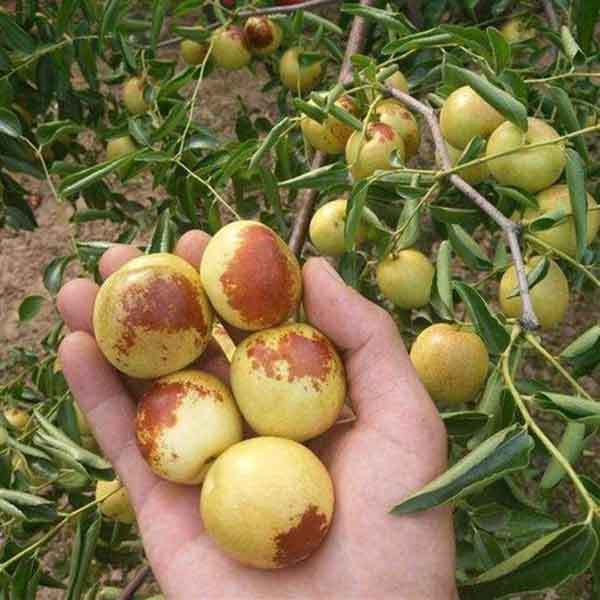How To Grow Jujube From Seed - Wilson Garden
Is jujube a tree or a shrub?
Jujube is a tree which produces small berries. The jujube tree grows well in U.S. Department of Agriculture plant hardiness zones 7 through 10, depending on the cultivar and other factors.
Are jujubes easy to grow?
Jujubes trees are easy to grow and have an attractive reddish brown bark. They require little maintenance. This makes them a good plant for beginners. Growing jujube's is a great way to explore gardening as a hobby without investing too much time and money initially.
Can you grow jujube from seed?
Yes, you can plant jujube from seed. An Asian shrub that produces sweet and sour fruit in the fall, jujube trees (Ziziphus jujuba) are hardy in U.S. Department of Agriculture plant hardiness zones 7 to 10. The fruit takes 3 to 4 years to reach maturity after planting a tree, but seeds can be harvested sooner if you are growing jujube from seed indoors.
Can jujube be grown in pots?
You can grow jujube trees in pots. But you should provide more space for large jujube trees. You should transplant jujube trees into large nursery pots within one year. Jujube trees require plenty of sunlight, mild temperatures and regular watering.
Do jujube seeds need cold stratification?
You don't need cold stratification jujube seeds, but stratification makes jujube seed germination easier. You can simply keep the top of your potting soil moist and warm (between 70-85 degrees Fahrenheit) to germinate jujube seeds. Place the seeds in a container filled with damp sand or expanded perlite and keep them at about 50 degrees Fahrenheit for 2 weeks.
Do I need to soak jujube seeds before planting?
Soaking the seeds before planting speeds up the jujube germination process. Covering the seeds with clean water and allowing them to soak for 1–2 days will help soften their outer coating, allowing better seed germination and healthier plants.

What kind of soil does a jujube tree need?
They prefer sandy and well-drained soil. A good soil mix should include one part peat moss and one part sand. It takes time for these trees to grow and fruit. But when they start producing, you can enjoy sweet, tangy and juicy fruit for much of the year.
When should I plant jujube seeds?
The best time for planting jujube seeds is in early spring as newly planted trees will begin fruiting within three years. They will germinate within 30 days after sowing as long as conditions are favorable (exposure to sun, watering). Water regularly until they have rooted well.
How far apart should you plant jujubes?
You should space jujube trees out at least 10 to 15 feet apart. Plant the seeds about 2cm deep in fertile, sandy soil with good drainage. You need to keep the tree well watered, or you may risk root rot and fruit drops.
How to grow jujube from seed?
Jujube is a deciduous fruit tree known for its delicious fruit. You can eat it fresh or use it in cooking. You can try this simple and easy method if you want to grow jujube from seed.
Jujubes are easily propagated from seed, making it possible for gardeners to grow the plants in areas where cultivation is difficult or impossible. The key is to find a nursery that sells seeds and gets fresh seeds since old ones can take years to even begin to germinate.
You need to soak the seeds for about 24 hours. Then, plant them in the warm soil about 2 cm beneath the surface. Plant the seeds 10 inches apart in rows and spaced 15 inches apart. Water thoroughly but do not over-irrigate. Keep the soil moist until germination occurs. This may take up to 6 weeks.
How often should you water a jujube?
Jujubes should have at least 1 inch of water each week for best growth and fruit production. In their first year, they require even more water than other fruiting plants because of the years of dormancy and size of the root system.
You should water it in the early morning or late afternoon. This allows the fruit trees to dry before nightfall. Remove any weeds growing near the tree to prevent competition for water and nutrients.
What is the best fertilizer for jujube?
Jujube is a vigorous grower and can utilize many types of fertilizers. Fertilizers containing nitrogen, phosphorus and potassium are best for jujube, such as 10-10-10. A fertilizer applied in early spring will give the trees a head start on growth. Apply additional fertilizer during the growing season as green leaves begin to change color to yellow or red and watch for fruit production.
Do jujube trees need full sun?
Jujube trees need full sun for optimal growth. Jujubees should be planted in an area with full sun exposure all year, ideally with a slight southern or eastern exposure for better fruit production. While some shade is tolerable, trees need at least six hours of direct sunlight per day to stay healthy and produce fruit in abundance.
Is jujube self pollinating?
Jujube is self-pollinating, but it blooms in clusters. When you find a tree with one large cluster of flowers and several smaller clusters nearby, remove one small branch from the larger cluster for pollination and then remove all other fruiting branches from the tree except for two or three.

How long does it take jujube tree to fruit?
Jujube fruit trees will produce fruit as soon as they are 4-5 years old. This depends on the cultivar, growth and care in different regions. Small trees require more time to reach maturity than large ones.
What month is jujube season?
Jujube season is between September and November. Jujubes are native to China, but they grow best in warmer areas like California and Texas. There are two kinds of jujubes: red and yellow; either one makes a tasty treat in baked goods and sweet drinks.
How do you know when a jujube is ripe?
Jujubes have a variety of health benefits and are packed with antioxidants. Jujubes are ready to be picked when their color changes from green to a reddish-brown or bright yellow color. Sometimes they will have some yellow spots on them. This means that they are ready. You should pick them right off the tree as soon as they ripen.
How do you harvest jujube?
To harvest jujube, pick the fruit off the tree by hand. Select fully ripe pieces that are blemish-free and have a slightly waxy feel to them. Harvesting should be done when the fruit is firm and has a red color. The fruits are very sensitive to moisture and will start to shrink once picked if left on the tree for too long. The fruits can then either be eaten fresh or dried for storage.
How many jujubes can a tree produce?
A mature jujube tree can produce 40 to 100 lb of fruit or more. The average yield varies with cultivar, location and growing conditions. If you care for jujube trees properly, they will produce huge amounts of fruit year by year.
Do jujubes ripen after picking?
Jujubes, if picked from a tree before they are ripe, will not ripen. Green fruit will not ripen after picking. If you’re planning to eat them soon and want to bring out their sweetness as much as possible, store your jujubes at room temperature. If you want them to keep longer (and become sweeter), then leave them in a paper bag on the counter or in your refrigerator.
How long does a jujube tree live?
Jujube trees, also known as Chinese date trees, produce high-quality edible fruit with a flavor that's closer to an apple than most dates, making them ideal for eating fresh out of hand or in desserts. The average lifespan of a jujube tree is 50 years or more if it's planted in a commercial orchard, but you may be able to extend its life and productivity by training the tree like other fruit trees.
How do you prune jujube?
Jujube trees require moderate pruning to maintain their shape and vigor, but heavy pruning will destroy them. Prune the tree in winter or early spring when the buds are beginning to swell.
If your jujube trees are too vigorous and don't fit into their space, prune the branches back to a place where you will still have plenty of leaf and fruit production. If you want to thin out a young tree's branches and you live where cold temperatures don't extend into fall, wait until early summer before removing branches.
How do you care for jujube?
Jujube are low-maintenance trees that require little care. Their adaptability to different growing conditions makes them suitable for small yards and containers. They prefer well-drained soil, full sun and regular watering. You should water it once a week during the summer months. The best time to water is early morning between 7-8 am.
We also recommend that you keep weeds under control. Because they can compete with the jujube for needed moisture and nutrients in the soil. If you see any diseases or pests on your tree, treat accordingly and remove dead or infested branches immediately.
How cold hardy are jujubes?
Jujube is hardy to minus 20 degrees or below. Its resistance to cold may be attributed to its thick bark and low chilling requirement, which makes it suitable for planting in areas with cold winter climates.
In the winter, you can protect the jujube tree from cold temperatures. For example, wrap it loosely in burlap and place a blanket around it. Do not cover the entire tree; just enough of an opening for the sun to warm it.

Do jujube trees lose their leaves in winter?
Jujube trees lose their leaves in fall. The leaves turn tan, yellow and orange before falling in autumn. In the springtime new green leaves emerge from the branches and start growing again.
The main reason that they drop their leaves is to prevent moisture loss during severe cold temperatures, or when there is a lack of precipitation or rainfall. This process helps them to conserve energy for the spring growing season. It also protects themselves from potential damage caused by cold weather conditions.
Do jujube trees go dormant?
Jujube trees go dormant in the winter, just like other fruit trees. To be considered dormant, a plant must be completely devoid of leaves and all other signs of growth. During this dormant period, you should remove all leaves and fruits from the tree. Do not water a jujube tree during their winter dormancy.
Do jujube trees have deep roots?
Jujube trees have deep roots and they can extend 12-25 feet deep, providing large amounts of water and nutrients. This anchors it well in the ground to prevent damage from high winds or earthquakes. The deep roots help your tree get the most out of the soil it is growing in. Then, it continues to grow strong and healthy.
Can jujube grow from cuttings?
Jujube can grow from cuttings. You will need to select healthy mature trees and cut off branches or twigs with at least four leaves on each one. Keep the severed ends of the cutting moist until they are planted, but do not over water them as this can cause decay.
You can take cuttings in spring and summer and place them in soil or water to root. The best time to do this is when you see new growth on your trees. As long as they grow fast enough, they should root within a few weeks.
Does jujube need to be grafted?
Yes, jujube can be grafted. Grafted plants are more vigorous and bear fruit earlier than seedlings. Grafting is a standard method of vegetative propagation that is often used in the production of jujube trees.
The main reasons for grafting include: to increase fruit yield and quality, to impart new characteristics or horticultural traits, and/or to propagate certain cultivars that are difficult to propagate from seed.
Are red dates and jujubes the same?
Jujubes and red dates are the same. They are native to Asia and grown for their sweet fruits which are used in jams and jellies, candies and teas.



